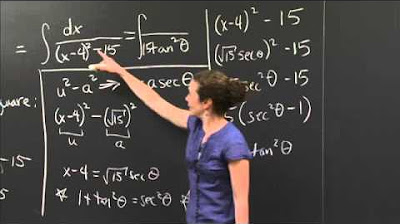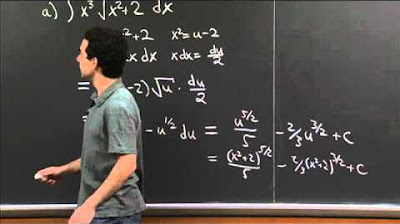Integrals: Trig Substitution 3 (long problem)
TLDRThe video script presents a complex calculus problem involving the indefinite integral of the square root of a polynomial expression. The solution process is intricate, involving completing the square, trigonometric substitution, and the use of trigonometric identities. The problem is solved by transforming the expression into a form that allows for the application of cosine squared and sine squared relationships, leading to the eventual simplification and integration. The final antiderivative is expressed in terms of an arc sine function and a radical involving the original polynomial.
Takeaways
- 🔍 The problem involves finding the indefinite integral of the square root of (6x - x^2 - 5).
- 📚 U-substitution is not immediately applicable due to the complexity of the expression.
- 📐 A trigonometric substitution is suggested as a potential method to solve the integral.
- 🔢 The expression is first transformed by completing the square to resemble a form suitable for trigonometric substitution.
- 🌐 The transformation process involves rewriting the expression to match patterns conducive to trigonometric substitution, such as 1 - x^2 under a radical sign.
- 🔄 Through algebraic manipulation, the expression is rewritten as an integral involving the square root of (4 - (x - 3)^2).
- 📐 The substitution x - 3 / 2 = sin(θ) is used to convert the expression into a trigonometric form.
- 🔄 The derivative dx in terms of dθ is found, which is dx = 2cos(θ)dθ.
- 🔄 The integral is then rewritten in terms of θ, involving the square root of cosine squared θ.
- 📐 The trigonometric identity cos^2(θ) = (1 + cos(2θ)) / 2 is applied to simplify the integral further.
- 🔄 The antiderivative is found to be 2θ + 2sin(θ)cos(θ) + C, which is then expressed in terms of x by substituting back for θ.
- 📊 The final antiderivative is a combination of terms involving the arc sine function and the square root of a quadratic expression in x.
Q & A
What is the original integral expression given in the transcript?
-The original integral expression is the indefinite integral of the square root of (6x - x^2 - 5).
Why was u-substitution not considered as a viable method for solving the integral?
-U-substitution was not considered because the given expression did not match the typical forms that lend themselves easily to u-substitution, such as 1 - x^2, x^2 - 1, or x^2 + 1 under a radical sign.
What is the significance of completing the square in the process of solving this integral?
-Completing the square was necessary to transform the given expression into a form that could be more easily handled with trigonometric substitution, which was the chosen method for solving the integral.
How was the expression transformed to resemble a suitable form for trigonometric substitution?
-The expression was transformed by completing the square and rewriting it as the square root of (4 - (x - 3)^2), which then allowed the trigonometric identity involving sine and cosine to be applied.
What trigonometric identity was used to simplify the integral?
-The identity used was cosine squared theta = (1 + cosine of 2 theta) / 2, which helped to simplify the integral into a more manageable form for solving.
How was the variable 'theta' defined in terms of 'x' during the trigonometric substitution?
-Theta was defined in terms of 'x' by setting (x - 3) / 2 equal to sine of theta, which was derived from the trigonometric substitution step.
What was the final form of the antiderivative obtained in the solution?
-The final form of the antiderivative was 2 * arc sine of (x - 3) / 2 + (x - 3) / 2 * sqrt(6x - x^2 - 5) + C, where 'C' represents the constant of integration.
What was the purpose of the trigonometric identities used in the solution?
-The trigonometric identities were used to simplify the integral into a form that could be easily integrated. They helped to express the cosine terms in terms of sine and other simpler expressions, which are easier to integrate.
How was the derivative dx/dθ used in the substitution process?
-The derivative dx/dθ, which is equal to 2 cosine of theta d theta, was used to replace dx in the integral. This allowed the integral to be solved by working with the simplified trigonometric expressions.
What was the role of the sine and cosine functions in the solution?
-The sine and cosine functions played a crucial role in transforming the given expression into a form suitable for integration. They were used in the trigonometric substitution and in the simplification of the integral through the use of trigonometric identities.
What was the final step in the solution process?
-The final step was to perform the reverse substitution, replacing theta with its equivalent expression in terms of 'x', and simplifying the expression to obtain the final form of the antiderivative.
Outlines
📚 Introduction to Trig Substitution
The paragraph introduces a complex indefinite integral involving the square root of a quadratic expression. The speaker explains that u-substitution is not applicable here and suggests the need for a more advanced method, specifically trigonometric substitution. The speaker then discusses the typical forms that prompt the use of trig substitution, such as 1 minus x squared or x squared minus 1 under a radical sign, but notes that the current expression does not match these forms. The goal is to transform the given expression into a form that is more conducive to trigonometric substitution.
🔍 Completing the Square and Trig Substitution
In this paragraph, the speaker begins the process of transforming the given integral by completing the square. This involves rewriting the expression to resemble a perfect square form, which ultimately leads to the expression 4 - (x - 3)^2. The speaker then factors out a 4 and recognizes that the new form looks more like the types of expressions that can be handled with trig substitution. The indefinite integral is then rewritten in terms of a new variable, theta, using the identity relating sine squared to 1 minus cosine squared.
📝 Solving for Theta and Substitution
The speaker now focuses on solving for theta in terms of x, which is necessary for the trig substitution. By manipulating the equation relating x to sine(theta), the speaker finds that theta equals the arc sine of (x - 3) / 2. The next step is to find dx in terms of d theta, which is done by differentiating the equation for theta with respect to x. The speaker then substitutes these expressions back into the original integral, resulting in a new integral in terms of theta. The paragraph concludes with the integral now expressed in a more manageable form involving cosine squared theta and dx.
🎓 Simplifying the Antiderivative
The final paragraph is dedicated to simplifying the antiderivative obtained from the previous steps. The speaker uses trigonometric identities to rewrite the cosine squared term in the integral. After several algebraic manipulations and substitutions, the speaker arrives at an expression involving the arc sine function and the square root of a quadratic expression in x. The speaker emphasizes the complexity of the problem and the satisfaction of reaching the final antiderivative form. The integral is now expressed in a form that is the antiderivative of the original complex expression, showcasing the power of trig substitution in solving difficult integrals.
Mindmap
Keywords
💡indefinite integral
💡u-substitution
💡trig substitution
💡completing the square
💡factoring
💡trigonometric identities
💡derivative
💡antiderivative
💡substitution
💡simplification
Highlights
The indefinite integral of the square root of 6x - x^2 - 5 is discussed, which is not a simple integral.
The problem does not lend itself to u-substitution or trig substitution at first glance.
The process of completing the square is demonstrated to transform the given expression.
The integral is algebraically rewritten to resemble a form suitable for trig substitution.
Trig substitution is used with the recognition of cosine squared theta as a key step.
The substitution x - 3 / 2^2 = sin^2(theta) is established for trig substitution.
Solving for theta in terms of x is necessary before proceeding with the substitution.
Derivative calculation dx = 2cos(theta)dtheta is found for the substitution.
The integral is expressed in terms of theta, involving the square root of cosine squared theta.
Utilization of trig identities, specifically cosine squared theta = 1/2(1 + cos(2theta)), simplifies the integral.
The antiderivative is found to be 2theta + 2sin(theta)cos(theta) + C.
Simplification of the antiderivative is attempted by converting everything to sines of theta.
The double angle identity for sine is used to further simplify the expression.
Back substitution from theta to x is performed to find the final antiderivative in terms of x.
The final antiderivative is given as 2arcsin(x - 3/2) + (x - 3/2)sqrt(6x - x^2 - 5) + C.
The problem demonstrates the complexity and depth of certain indefinite integrals requiring advanced techniques.
The process showcases the power of trigonometric substitutions and identities in solving difficult integrals.
Transcripts
Browse More Related Video

Integration by completing the square | MIT 18.01SC Single Variable Calculus, Fall 2010

Integration Practice III | MIT 18.01SC Single Variable Calculus, Fall 2010

Integrals: Trig Substitution 2

5.2.3 Identities in Calculus

Indefinite Integral

Integration using completing the square and the derivative of arctan(x) | Khan Academy
5.0 / 5 (0 votes)
Thanks for rating: